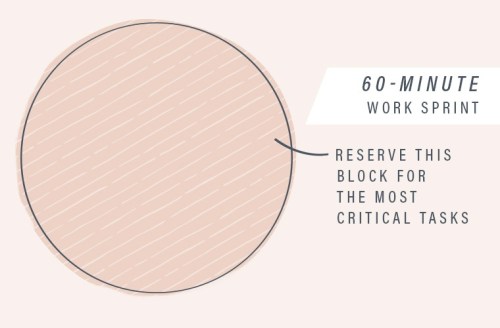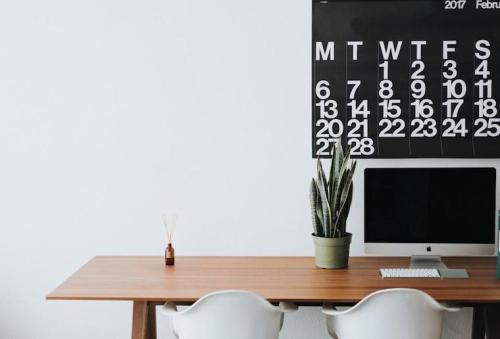Six o’clock rolls around and with a little luck (and a whole lot of hustle) you’ve decluttered your inbox, hosted a killer brainstorm session with your team, and bossed your to-do list. That post-work apple cider vinegar soak feels especially lavish when you can leave the day’s tasks behind you and float into anti-inflammatory heaven sans guilt.
Despite your best intentions, though, you spend the last few minutes of the workday reflecting on all the things you didn’t get to strike off your list. Taking work home is just too easy when it’s not getting done at the office.
“The best time managers in the world are very self-aware.”
Julie Morgenstern, best-selling author and time-management expert, offers a fresh take on productivity, one that emphasizes trying out different schedules the same way you would pairs of leggings—until you find one that fits you just right. “The best time managers in the world are very self-aware,” Morgenstern says. “They understand how long things take for them to do, and how much time is the right amount of time.”
Below, Morgenstern shares three hour-long frameworks for dividing your day into digestible chunks. Start by taking a look at the tasks you need to accomplish, then determine which type of hour best fits your goals. Repeat until all eight hours are filled. And voila, you have one seriously worthwhile day ahead of you.
Keep scrolling for the only productivity hack you need.

The 60-minute work sprint
Dedicate the entire, interrupted hour to a single, top-priority task (AKA anything you felt the need to triple underline in your planner). Avoid the temptation to check your email or take a matcha break. Instead, double down and make a dent in your most critical project.
When does this strategy work best? “For most people, the mornings are better for peak brain power stuff,” says Morgenstern. You may have noticed that your inbox is also relatively quiet during the a.m., making it the perfect time to take a deep dive in the tasks that will require the most concentration.
Why use it? The 60-minute work sprint makes room in your day for what Morgenstern terms “legato tasks,” or action items that are best executed without distractions. “People are so overwhelmed with competing priorities that they go to email to feel like they’ve gotten something done. But it’s a trap. It steals your energy. It steals your time,” Morgenstern says. By completing the most important stuff in the morning, you work with your brain instead of against it. “Your brain really engages more deeply when you don’t reward it with a quick fix.”
Morgenstern’s pro tip: To tackle an especially difficult task, stack two to three of these 60-minute blocks in a row. This will keep you from stretching a two-hour task into a week-long struggle.

The 40-20 work dash
If the idea of focusing on a single task for 60 minutes makes you want to invest in an anxiety-reducing watch, try filling your day with these 40-20 work dashes. Take the first 40 minutes of each hour to plow through key tasks, then cool down by answering emails or touching base with teammates.
When does this strategy work best? Morgenstern says this method works best in the morning or early afternoon.
Why use it? Multiples of 20 hit the sweet spot as far as productivity goes. In Goldilocks terms, that amount of time is not too long and not too short, but just right. “You can get a lot done in 40 minutes,” says Morgenstern. “If you try to do 45 minutes on one thing and 15 on another, that 15 minutes is always too [rushed].”
Morgenstern’s pro tip: Stick to your schedule, even if you’re on a roll when the timer goes off. “Keeping promises to yourself is important. Fake-outs make it harder later,” she says. Think of your daily plan as a contract with yourself. Breaking the agreement once or twice is no big deal, but eventually, you might backslide into ditching your schedule altogether.
20-20-20 work intervals
If your to-do list had a HIIT portion, the 20-20-20 would be it. This three-pronged approach to an hour includes 20 minutes of zeroing in on a critical task, 20 minutes committed to a mid-level priority, and 20 minutes of communication.
When does this strategy work best? The homestretch of your day.
Why use it? “As the day wears on, we get more interruptions, more frantic last-minute requests, and so on,” Morgenstern says. These increments leave space for you to jump on up any tasks that might come your way, while still leaving dedicated time for your day-to-day necessities.
Morgenstern’s pro tip: Twenty-minute blocks are ideal for setting aside time for yourself: “You should be able to take a 20-minute break and completely lose track of time, get fully present with whatever you’re doing,” she says. Whether that means fitting in a quickie workout, opting for a walking meditation, or having a Bitmoji convo with your friend.
If your work-life balance is out of whack, here are 6 ways to maintain healthy boundaries. Plus, the 9 small planters you need for your desk.
Sign Up for Our Daily Newsletter
Get all the latest in wellness, trends, food, fitness, beauty, and more delivered right to your inbox.
Got it, you've been added to our email list.












